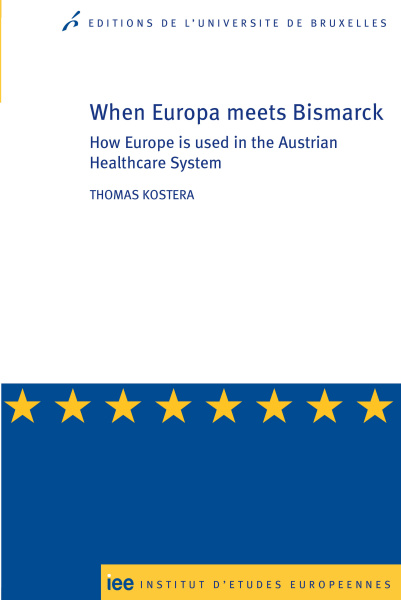When Europa meets Bismarck
How Europe is used in the Australian Healthfare System
Première édition
What happens when the European Union sets new rules for the provision of cross-border healthcare services that were conceived for the population living on the national territory? Does Europe destabilize national social solidarity? Do actors that govern the healthcare system further or resist the Europeanization of their national healthcare system? Lire la suite
Taking Austria, a prototypical Bismarckian healthcare system, as an example, this book aims at answering these questions by looking at how actors navigate between national institutional constraints and European opportunities. It presents how new rules on the provision of cross-border healthcare in the European Union have the potential of destabilizing national welfare boundaries.
Taking a sociological approach to Europeanization, it is analysed if and how actors adapt to such new rules.
An added value of the volume is to present the development of Austria's healthcare system in the "longue durée" through four political regime changes over the last 150 years, with European integration as the last wave of transformation to date. It shows that cross-border healthcare provision is already a well integrated practice; and how providers and payers of healthcare deal with European requirements and voice their policy preferences in the Brussels arena. Overall, it suggests both the flexibility and the resilience of the national models of welfare.
Spécifications
- Éditeur
- Éditions de l'Université de Bruxelles
- Auteur
- Thomas Kostera,
- Collection
- Études européennes | n° 59
- ISSN
- 13780352
- Langue
- anglais
- Site web ressource
- Oapen.org
- Catégorie (éditeur)
- > Science politique
- BISAC Subject Heading
- POL058000 POLITICAL SCIENCE / World / European
- Code publique Onix
- 06 Professionnel et académique
- CLIL (Version 2013-2019 )
- 3283 SCIENCES POLITIQUES
- Subject Scheme Identifier Code
- Classification thématique Thema: Politique et gouvernement
Livre broché
- Date de publication
- 28 novembre 2016
- ISBN-13
- 978-2-8004-1611-3
- Ampleur
- Nombre de pages de contenu principal : 240
- Code interne
- 1611
- Format
- 160 x 240 x 15 cm
- Poids
- 397 grammes
- ONIX XML
- Version 2.1, Version 3
ePub
- Date de publication
- 03 mai 2019
- ISBN-13
- 978-2-8004-1666-3
- Contenu du produit
- Text (eye-readable)
- Ampleur
- Nombre de pages de contenu principal : 240
- Code interne
- 1666
- Epub-Édition accessible
- Table of contents navigation
- ONIX XML
- Version 2.1, Version 3
Google Livres Aperçu
Sommaire
- List of Figures and Tables
- Acknowledgements
- 1. Introduction
- 1.1 Case Selection and Structure of the Book
1.2 Institutional Regimes and Agency in a Bismarckian Healthcare System
1.2.1 Building Welfare Institutions and Healthcare Systems
1.2.2 Welfare States as Institutional Regimes
1.2.3 Bismarckian Welfare Regimes and Healthcare Systems
1.2.4 Actors' Interests in a Bismarckian Healthcare Systems
1.3 National Actors’ Usages of Europe
- 2. Dynamics in the Austrian Healthcare System: History, Governance, Funding, and Provision
- 2.1 The Historical Development of the Austrian Welfare State and Healthcare System
2.1.1 The Creation of Social Insurance under the Austro-Hungarian Empire (1880s-1918)
2.1.2 Social Insurance and Change(s) of the Political Regime (1918-1945)
2.1.2.1 The First Republic (1918-1934)
2.1.2.2 The Corporative State (Ständestaat) and Nazi Occupation (1934-1945)
2.1.3 Consolidation of the Welfare State in the Second Republic (1945-1980s)
2.1.3.1 Political Consolidation and the Role of Political Parties
2.1.3.2 Social Partnership
2.1.3.3 The General Social Security Act: Centralisation and Expansion
of the Austrian Welfare State
2.1.3.4 The Welfare State and the Kreisky Era (1970-1983)
2.1.3.5 15a Agreements: Cooperative Federalism in Healthcare since the 1970s
2.1.4 Austria and Initial Reforms of the Welfare State (1983-1995)
2.1.5 Adaptations to Europe and Welfare State Reforms (1995-1999)
2.1.5.1 EU Membership and Welfare State Reforms
2.1.5.2 Europeanization Effects
2.1.6 Austerity and Reforms of the Welfare State during the 2000s
2.1.7 Interim Conclusion: the Different Phases of Welfare State Development
2.2 Austrian Healthcare Governance: a Complex and Fragmented System
2.2.1 Main Actors in Healthcare Governance
2.2.2 Inert Structures and Practices: Path-dependent Governance Reforms
2.3 The Financing Structure of Austrian Healthcare
2.3.1 Financial Flows and Actors’ Interests in the Healthcare System
2.3.2 The Financial Interplay between the National and the Regional
Level in Inpatient Care
2.4 The Provision of Healthcare in Austria
2.4.1 The Structure of Healthcare Provision
2.4.2 Interim Conclusion: Institutional Dynamics, Actors’ Practices and
Cross-border Healthcare
- 3. European Integration and Cross-border Healthcare
- 3.1 European Limits to Member States’ Social Sovereignty
3.2 European Integration and Healthcare
3.3 The EU as a Quasi-Federal Opportunity Structure in Healthcare
3.4 Cross-border Patient Mobility in Austria
- 4. Usages of Europe in the Austrian Healthcare System
- 4.1 Challenging Boundaries? Cross-border Hospital Collaboration and Regional Experiences
4.1.1 Cross-border Collaboration between Austria and Germany
4.1.2 Cross-border Collaboration between Austria and the Czech Republic
4.1.3 Lower Austrian Usages of Europe at European Level
4.1.4 Cross-border Healthcare: More of a Burden than an Opportunity for Regions?
4.1.5 Discussion: Regional Usages of Europe and Cross-border Healthcare
4.2 Usages of Europe by Corporate Actors
4.2.1 Payers: Perception and Management of Cross-border Healthcare
4.2.2 Payers’ Usages of Europe
4.2.3 Providers: the Medical Profession and Cross-border Healthcare
4.2.4 Providers’ Usages of Europe at National and European Level
4.2.5 Discussion: Usages of Europe by Corporate Actors
4.3 Interim Conclusion: Usages of Europe and National Boundaries
- 5. Conclusion
- References
Primary Sources
Official and Public Documents
Newspaper Articles
Secondary Sources
Analytical Reports, Working Papers, Conference Papers
Articles
Books and Book Chapters
List of interviews

